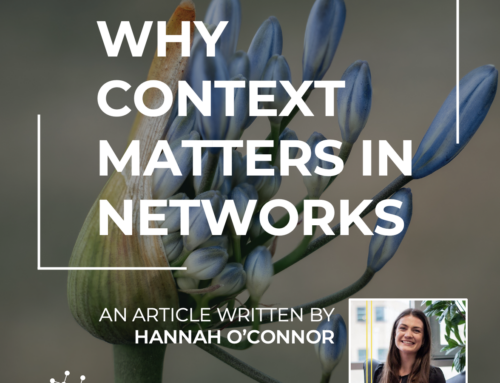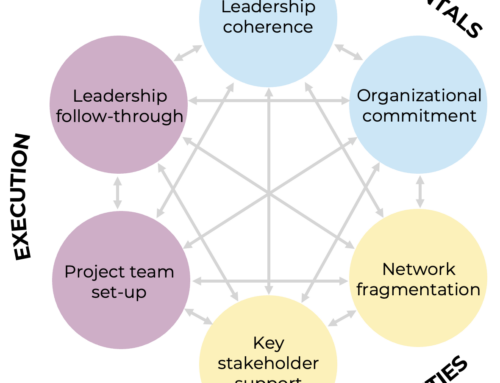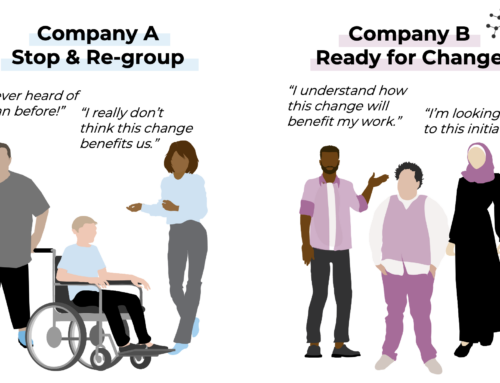
Show me your network and I will show you how your organization works!
It may sound as the consultant trying to sell you his knowledge or his product, because how can you seriously claim that you can in practice show the world how a public organization with 4,000, 5,000 or maybe 20,000 employees works? The municipality reform in Denmark has created some enormous public organizations, where many are now bigger than the biggest Danish private companies.
Normally, the organizational structure is illustrated with a diagram. The boxes and their connections. Even the most optimistic hierarchical theoreticians agree that these structures often only mediate disagreements – and under no circumstances provide a full picture of how an organization works in practice.

Silo thinking, lacking cross functional collaboration and flexibility is a reoccurring topic in large organizations. For most of these organizations it is hard to solve these challenges; to transform the good intentions to more than words.
When it is hard to solve the challenge, the reason is, that there is not one single solution. Cross functional collaboration is different depending on the context. Does everyone in the organization need to collaborate or are some relationships stronger than others? And then comes the hardest questions; how do we know what a strong collaboration is? How do we know if our employees are satisfied with the collaboration? How can we identify potentially important collaborators? Until now it has been nearly impossible to answer these questions beyond the “we think…” level.
Getting back to the header of this writing: “Show me your network and I will show you how your organization works!”
Public organizations are now following the footsteps of some of Denmark’s biggest private companies e.g. Novo Nordisk, to map their collaborative relationships with help from the tool of Organizational Network Analysis.
Here organizations, among other things, can receive data and insights on:
- How close is the collaboration in an organization across employees, leaders, departments etc.?
- How well do individuals know each other’s competencies?
- How much energy do the people get out of the collaboration?
- How can you identify unutilized potential collaborations to increase the efficiency?
- How satisfied are you with the collaboration?
These questions can be answered by looking back at the header of this writing; “Show me your network and I will show you how your organization works!”

The Municipality of Helsingør
The Municipality of Helsingør in Denmark was the first organization in the public sector, which utilized this tool on a large scale. The purpose of the analysis was to create knowledge and a solid background for a streamlining organizational change.
Instead of using gut feelings or purely subjective consulting, the municipality undertook an investigation of the existing ability, satisfaction and potential of its collaboration.
The investigation provided everyone involved, including politicians and work place representatives with a clear picture of the challenges and with a possibility to act on data and concrete knowledge. Most important, it created a different and better organization than if they had left out the investigation of current collaboration.
The illustration below shows one of the many findings and insights from the Network Analysis provided for the municipality.

EXPLANATION TO ILLUSTRATION: Build, Plan & Infrastructure Department is seperated in two different fragmented blocks. One of the blocks has a high degree of collaboration with the Property Office. There is a clear potential of reorganization. What on paper appears to be two different departments, shows itslf in practice to contain completely different relations.
The network analysis was in the Municipality of Helsingør proved as a concrete and valuable tool to develop a new structure transforming 25 departments to 12 centers, by focusing on, which departments and collaborative relations worked well and where there was room for improvement. This evidence-based method of establishing the new organization, was remarkably different from the traditional approach and it meant that the municipality could within a period of six weeks complete a decision-process of the extremely thorough organizational change and streamlining, where there was acceptance of the premise that the decisions rested on agreement amongst stakeholders.
The Municipality of Odense
The Municipality of Odense undertook the biggest public Network Analysis in Europe in the Autumn of 2012 with 1,500 participants. The analysis contributed to a long list of organizational development processes, including a focus the municipality had put on the neighborhood of Vollsmose.
Here, the Network Analysis could for the first time map, who and how many work on the different challenges in the neighborhood and contributed to an overview, which completely changed the approach to the work from a project to an operations approach.

EXPLANATION TO ILLUSTRATION: This illustration is around one of the neighborhoods in Odense: Vollmose. 24% of the respondents identify Vollsmose as an important part of their field of work. That in itself is interesting, because it means that their be taken advantage of dedicating less, but more focused resources to the area. The density of employees in the group which has responded that they work with Vollmose is not very large. In other words, it is a relatively loose network. In the analysis a few key departments and key employees were pointed to as being central and to be very effective. It therefore presents an opportunity in the organization to being these closer together in collaboration
You can call this intelligent re-organization, where the municipality, based on data and knowledge, incorporates economy and rational decisions into the process. The benefits of time and money spent on analysis are quickly returned.
The Municipality of Sønderborg
The department of City, Land and Cultural Management in The Municipality of Sønderborg undertook a network analysis as a part of the assessment of the organization before a planned organizational change. One of the points of interest was how the collaboration among the employees, who had a major assignment of servicing the business community across the organization. In the same way, the analysis illustrated the employees, who had the important work assignment of providing citizen service.

The Municipality of Haderslev
The Municipality of Haderslev have in 2017 conducted a Network Analysis in the Adult Handicap department. In this analysis, the focus was the collaboration between employees responsible for citizens with handicaps of different types.

Network Analysis in itself is not what removes the subjectivity out of decision-making from the choices that need to be made when you are planning organizations or work processes, but it can give a mirror image of knowledge, which makes the subjective choice much more informed.
Reorganization is just an example of how Network Analysis can be applied. What about finding leaders and employees who are change agents? Who has the essential influence on collaboration?
The opportunities are enormous and the right questions just need to be asked. There is something about the saying: “Show me your network and I will show you how your organization works!”.
THIS IS A TRANSLATION FROM THE ORIGINAL DANISH ARTICLE WRITTEN BY JAKOB LUNDGAARD FROM LUNDGAARD KONSULENTERNE: http://www.lundgaard-konsulenterne.dk/. TO READ THE DANISH VERSION, GO TO: https://www.innovisor.com/da/2018/07/05/vis-mig-dit-netvaerk-sa-skal-jeg-fortaelle-dig-hvordan-din-organisation-virker/







